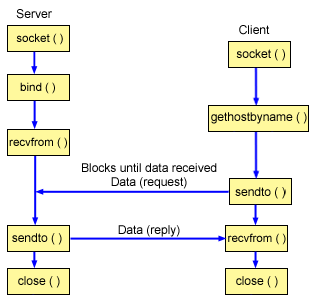Creating a connectionless socket
Connectionless sockets do not establish a connection over which data is transferred. Instead, the server application specifies its name where a client can send requests.
Connectionless sockets use User Datagram Protocol (UDP) instead of TCP/IP.
The following figure illustrates the client/server relationship of the socket APIs used in the examples for a connectionless socket design.

Socket flow of events: Connectionless server
The following sequence of the socket calls provides a description of the figure and the following example programs. It also describes the relationship between the server and client application in a connectionless design. Each set of flows contains links to usage notes on specific APIs. If you need more details on the use of a particular API, you can use these links. The first example of a connectionless server uses the following sequence of API calls:
 The socket() API returns a socket
descriptor, which represents an endpoint. The statement also identifies
that the Internet Protocol version 6 address family (AF_INET6) with
the UDP transport (SOCK_DGRAM) is used for this socket.
The socket() API returns a socket
descriptor, which represents an endpoint. The statement also identifies
that the Internet Protocol version 6 address family (AF_INET6) with
the UDP transport (SOCK_DGRAM) is used for this socket.
 After the socket descriptor is created, a bind() API
gets a unique name for the socket. In this example, the user sets
the s6_addr to zero, which means that the UDP port of 3555 is bound
to all IPv4 and IPv6 addresses on the system.
After the socket descriptor is created, a bind() API
gets a unique name for the socket. In this example, the user sets
the s6_addr to zero, which means that the UDP port of 3555 is bound
to all IPv4 and IPv6 addresses on the system.
- The server uses the recvfrom() API to receive that data. The recvfrom() API waits indefinitely for data to arrive.
- The sendto() API echoes the data back to the client.
- The close() API ends any open socket descriptors.
Socket flow of events: Connectionless client
The second example of a connectionless client uses the following sequence of API calls.
 The socket() API returns a socket
descriptor, which represents an endpoint. The statement also identifies
that the Internet Protocol version 6 address family (AF_INET6) with
the UDP transport (SOCK_DGRAM) is used for this socket.
The socket() API returns a socket
descriptor, which represents an endpoint. The statement also identifies
that the Internet Protocol version 6 address family (AF_INET6) with
the UDP transport (SOCK_DGRAM) is used for this socket.
 In the client example program, if the server string
that was passed into the inet_pton() API was not
a valid IPv6 address string, then it is assumed to be the host name
of the server. In that case, use the getaddrinfo() API
to retrieve the IP address of the server.
In the client example program, if the server string
that was passed into the inet_pton() API was not
a valid IPv6 address string, then it is assumed to be the host name
of the server. In that case, use the getaddrinfo() API
to retrieve the IP address of the server.
- Use the sendto() API to send the data to the server.
- Use the recvfrom() API to receive the data from the server.
- The close() API ends any open socket descriptors.